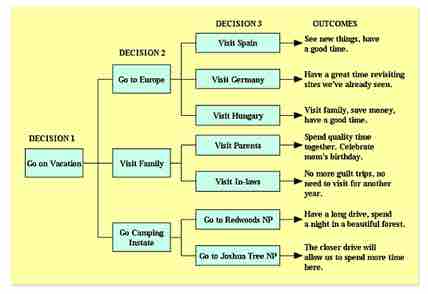The Vroom-Yetton-Jago model is a contingency approach to group decision making that is designed specifically to help leaders select the best approach to making decisions. The model identifies different ways a decision can be made by considering the degree of follower participation. It proposes a method for leaders to select the right approach to making a decision in a given set of circumstances.
Decision Types
The Vroom-Yetton-Jago model defines five different decision approaches that a leader can use. In order of participation from least to most, these are:
- AI – Autocratic Type 1: Decisions are made completely by the leader. Leaders make the decision on their own with whatever information is available.
- AII – Autocratic Type 2: The decision is still made by the leader alone, but the leader collects information from the followers. Followers play no other role in the decision-making process.
- CI – Consultative Type 1: The leader seeks input from select followers individually based on their relevant knowledge. Followers do not meet each other, and the leader's decision may or may not reflect followers' influence.
- CII – Consultative Type 2: Similar to CI, except the leader shares the problem with relevant followers as a group and seeks their ideas and suggestions. The followers are involved in the decision, but the leader still makes the decision.
- GII – Group-based Type 2: The entire group works through the problem with the leader. A decision is made by the followers in collaboration with the leader. In a GII decision, leaders are not at liberty to make a decision on their own.
Decision Trees
The Vroom-Yetton-Jago model also provides guidance for leaders trying to determine which approach to decision making to use (AI through GII). The model uses a decision-tree technique to diagnose aspects of the situation methodically. This technique involves answering a series of yes or no questions and following the yes path to the recommended type of decision-making approach.

Decision tree
This is an example of a decision tree. One decition (go on vacation) leads to further decisions (whether to go to Europe, visit family, or go camping), all of which lead to another tier of decisions. The Vroom-Yetton-Jago model utilizes decision trees to determine the best leadership style for a given situation.
- Is there a quality requirement? Is the nature of the solution critical? Are there technical or rational grounds for selecting among possible solutions?
- Do I have sufficient information to make a high-quality decision?
- Is the problem structured? Are the alternative courses of action and methods for their evaluation known?
- Is acceptance of the decision by subordinates critical to its implementation?
- If I were to make the decision by myself, is it reasonably certain that it would be accepted by my subordinates?
- Do my subordinates share the organizational goals to be met by solving this problem?
- Is conflict among subordinates likely in obtaining the preferred solution?
By answering the questions honestly, the decision tree provides the leader with the preferred decision style for the given situation.